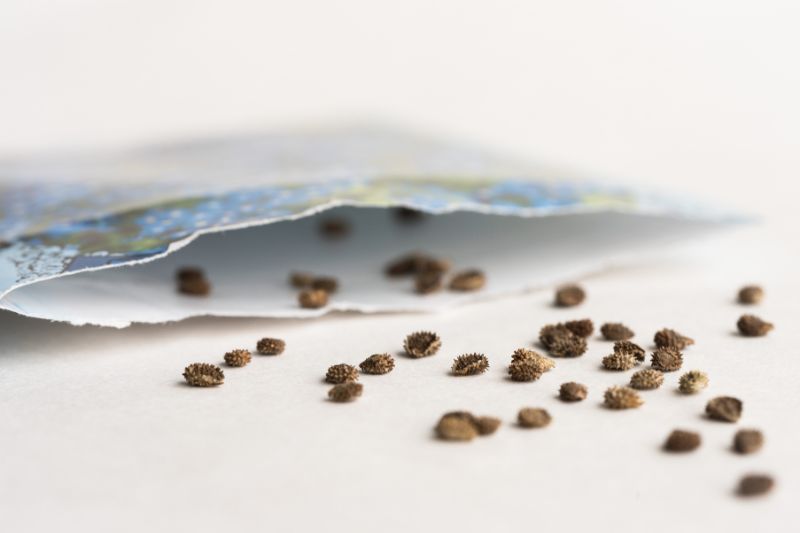Myosotis, also called "forget-me-not" or "lovewort", is a charming small plant that is easy to grow. These delicate blue star-shaped flowers (although some varieties are pink or white) add a splash of colour to gardens. Their ability to self-seed makes them particularly appealing to gardeners who want flowers with minimal effort. If you dream of seeing myosotis brighten your green spaces, follow this guide to succeed in sowing them at home.
Getting to know myosotis
Before planting, it helps to know a little more about this plant. Myosotis are perennial plants, often grown as annuals or biennials. They prefer damp spots, in full sun or partial shade, notably in woodland. They are ideal for flowering garden borders, dressing rockeries or creating tapetum of flowers under trees. Several myosotis species are found, among the most common are the wood forget-me-not (Myosotis sylvatica) and the alpine forget-me-not (Myosotis alpestris).
Myosotis mainly flowers in spring, between April and June, producing delicate blooms that last several weeks. They self-seed easily from one year to the next, and if you let them, you will have them each year with little effort.
Find all our myosotis varieties in plug plants and in seeds.
Choose the right time to sow
The ideal time to sow myosotis depends on how you want to grow them.
- Sowing outdoors : If you choose this method, the best period to sow is in summer, from July to September. This allows them to establish well before winter and to flower abundantly the following spring.
- Sowing indoors : If you want a better germination rate (or if you live in areas with very harsh winters), you can sow myosotis indoors in spring, around April/May. This will allow young plants to be ready to transplant outside at the end of spring.
Direct sowing outdoors
Prepare the soil
Myosotis prefer well-drained but slightly moist soil. Before sowing, prepare the chosen area by following these steps:
1- Shade level : If possible, choose a partly shaded spot, especially in warm regions. Full sun can sometimes dry plants out, particularly in summer.
2- Weeding : Make sure the area is clean and free of unwanted weeds. Myosotis do not like competition.
3- Loosen the soil : Aerate the soil by breaking it up with a broadfork or a spade. This helps roots establish more easily.
4- Add compost : Mix in some compost or organic fertiliser to enrich the soil. This will encourage good growth.
Steps to sow outdoors:
1- Scatter the seeds : Forget-me-not seeds are tiny, so sow them thinly on the soil surface. You do not need to dig holes.
2- Cover lightly : Press the seeds gently with the back of a rake or your hand to embed them slightly in the soil. You can add a fine layer of soil on top, but do not bury them too deeply (about 2 mm is enough).
3- Water gently : Use a watering can with a fine rose to avoid displacing the seeds. Keep the soil moist but not waterlogged.
4- Aftercare : Once sown, watch for young shoots. You will see the first leaves appear after 1 to 2 weeks. Keep the soil slightly moist, without waterlogging, during this germination period.

Sowing indoors
If you prefer to sow myosotis indoors to protect them from bad weather or to better control germination:
1- Use seed trays : Take small trays or seedling buckets. Fill them with a light potting compost that drains well.
2- Sow the seeds : As for outdoor sowing, scatter the seeds on the compost surface and cover them lightly.
3- Mist lightly : Moisten the compost with a spray bottle to avoid displacing the seeds. Compost should be damp but not waterlogged.
4- Place in a bright spot : Put your trays in a bright room, but away from direct sunlight. Ideal temperature is around 18–20 °C.
5- Transplanting : When plants reach about 10 cm in height and the risk of frost has passed (ideally when night temperatures are above 7–8 °C), you can plant them outside, in ground, in a pot or in a window box.
Care after germination
Once myosotis have germinated and started to develop, there are a few maintenance steps to follow to ensure a good flowering:
- Watering : Myosotis like moisture, especially during flowering. Ensure soil remains slightly moist, but avoid excess water.
- Removing faded flowers : If you do not want myosotis to self-seed all over the garden, cut off faded flowers before seeds form.
- Spacing : If sowing was too dense, thin out plants to give them room (about 15–20 cm between each plant).
- Winter protection : If you sowed late, cover young plants to protect them from winter frost.
Myosotis self-seed naturally
The good news with myosotis is that once established, they often self-seed where they please. You can let some flowers go to seed to enjoy new plants each year with no extra effort!

































Comments